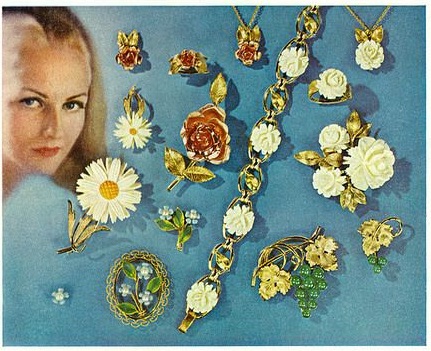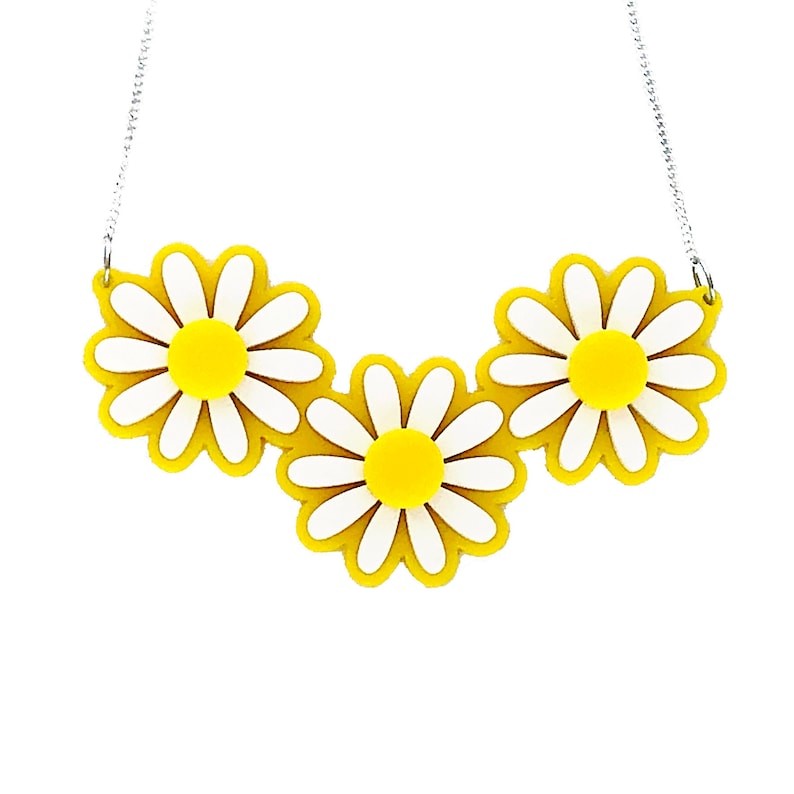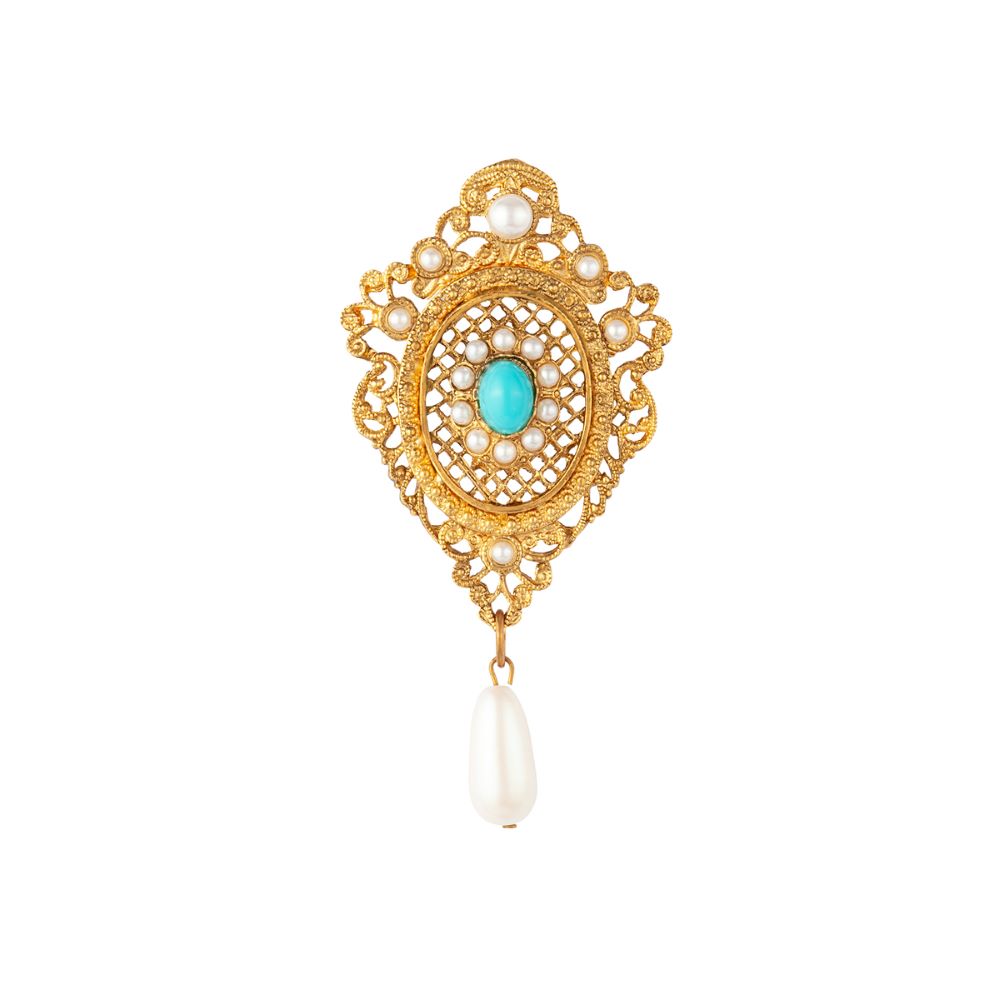In the beginning, costume jewelry of the 1960s looked very much the same as that of the previous decade. However, a change was stirring. Designs were becoming bolder and more expressive. By the end of the decade, 1960s jewelry styles had transitioned from familiar glitzy gold parures to fantastic bold creations fashioned in budget plastics. Femininity was out, and the Space Age was in.
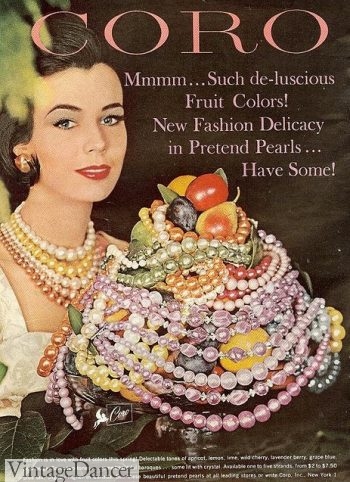
Early jewelry designs of the 1960s by Coro (Etsy). Beautiful pearls in pastel colors.
Suddenly, women’s 1960s fashion was available and accessible to everyone. The expansion of ready to wear clothing coupled with the span of clothing factories resulted in a market of mass production. New fake plastic-like fabrics and fibers replaced natural materials. Clothing was undergoing a transformation.
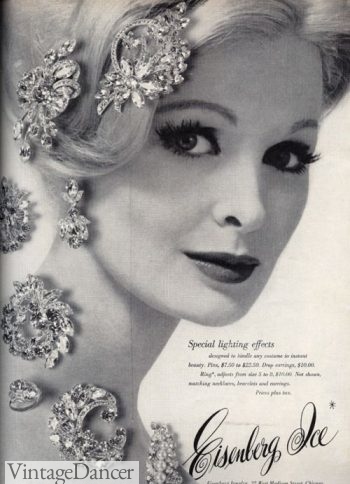
Gradually, 1960s jewelry styles would move away from the delicate sparkling styles popular throughout the 1950s. However, during the early years of the decade, rhinestone and paste styles (Etsy) were still preferred.
Costume jewelry designers of this time also experimented with new materials and techniques. Many designers rejected the ideas of jewelry representing status, instead producing designs in low cost materials. The new low cost, low value designs of the 1960s paved the way for an entirely new approach to fashion and consumerism.
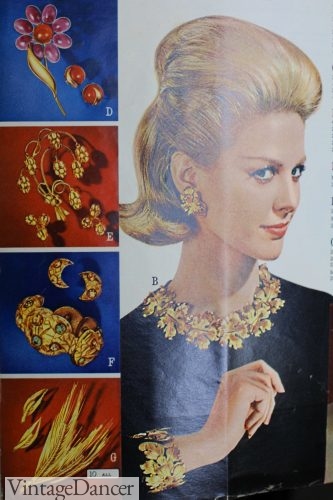
1964, gold jewelry was still very popular
1960s Jewelry Tends: Metals
At the beginning of the decade, 1960s jewelry styles (as with fashion) closely resembled the styles of the previous decade, the 1950s. Gold, colored pearls, and sparkling paste remained a popular choice.
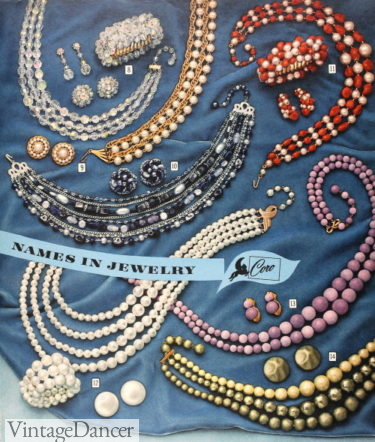
1961 colorful costume necklaces
Jewelry designers began to experiment more with the ideas of creating a textured surface to the jewelry. Textured gold was popular in the late 1950s, and remained so into the 1960s. Additional textures also emerged. A gritty effect dulling the shine of gold was created by fusing gold onto gold. Crumpled and hammered textures were also popular. In addition to gold, other metals were utilized during this decade.
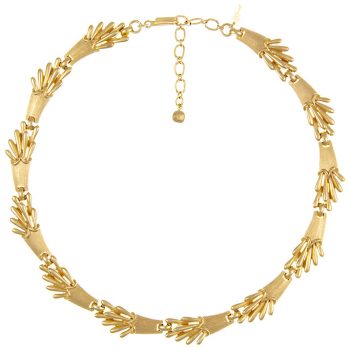
This vintage Trifari necklace (Etsy) is a perfect example of early 1960s gold jewelry.
Towards the end of the decade; the glitz and sparkle of paste and rhinestone were all but a distant memory. New sleek designs fashioned in metals with little or no accompanying decoration were on trend.
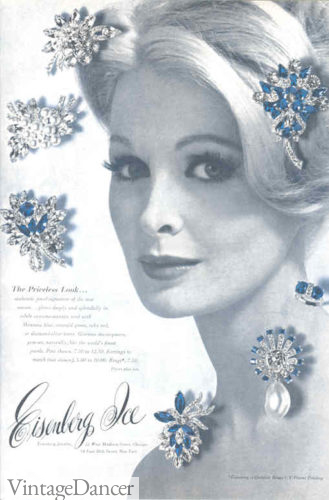
1962 sparkling evening jewelry
1960s Jewelry Styles: Geometric Shapes
The shapes utilized in jewelry designs became much bolder, and as a result, almost sculptural.
The Op Art and Pop Art movements of the decade not only influenced fashion, but also of course accessories and jewelry. Large geometric shapes mimicked the 1920s Art Deco movement. Circles, diamonds, spirals, and hexagons were all featured in these new jewelry styles.
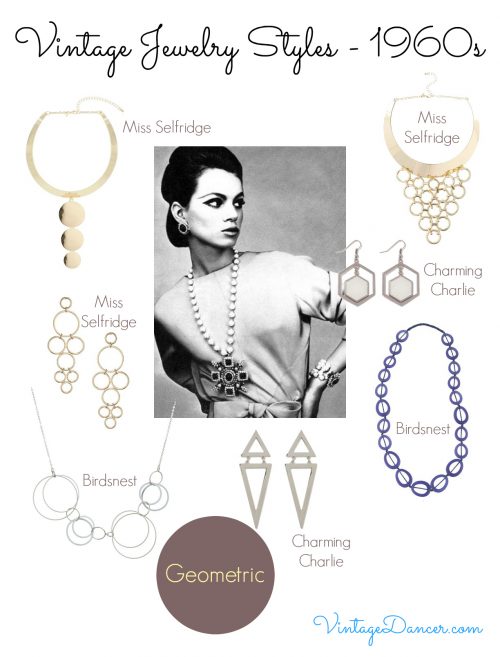
Geometric shapes dominated costume jewelry designs of the 1960s. Shop here.
1960s Jewelry Trends: Black and White
In the 1960s, fashion and art formed a perfect partnership. The mod shift dress, with its simple understated cut, was the perfect backdrop for displaying the bold prints of Pop and Op Art.
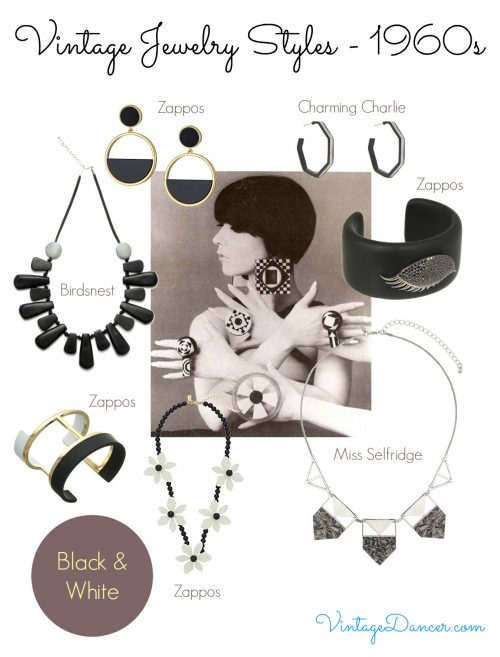
The Mod movement and Op Art contributed to the popularity of monochromatic jewelry styles.
Op Art featured a monochromatic palette to create complex designs and patterns, as a result of this, optical illusions were created. Jewelry designs complimented these trends. Black and white 1960s jewelry styles emerged in affordable low-cost plastics.
The Popularity of Plastic
Early plastics such as Bakelite and Catalin were developed at the beginning of the century. By the 1960s, advancements in technology produced new plastics. Design Kenneth Jay Lane made his statement with oversized plastic jewelry encrusted with rhinestones. Elizabeth Taylor and Audrey Hepburn were often seen wearing his jewelry.
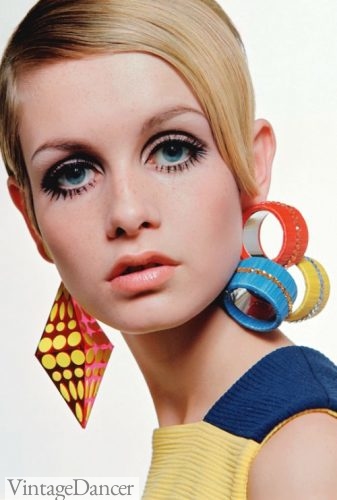
Fashion model Twiggy wearing a selection of plastic jewelry designs in 1967.
Resin, vinyl and Perspex could be produced on a mass scale, and at a very low cost. Paper, PVC , Lucite, and leather were other cheap materials. They allowed new ‘pop’ colors to shine: rich pink, turquoise, orange, and yellow. Jewelry designers seized the opportunity to produce designs in these new affordable materials.
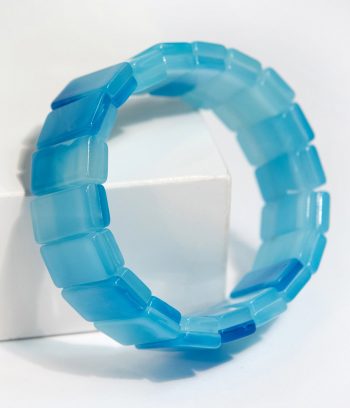
1960s inspired plastic bracelet at Unique Vintage
1960s Jewelry Designer: Lea Stein
Lea Stein had set up her own textile company in 1957. By the middle of the 1960s, she began designing and manufacturing buttons for the fashion and apparel industry. Towards the end of the decade, she started to produce her own jewelry designs. Stein used layers of colored cellulose acetate, which she bonded together to form her trademark character jewelry. Shop Lea Stein on eBay or on Etsy.
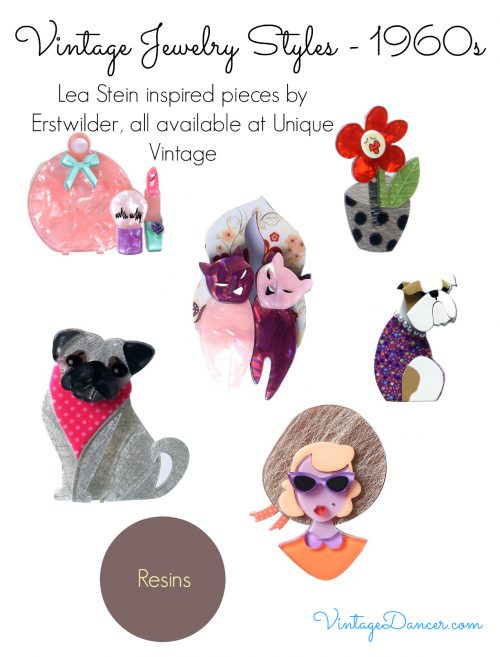
These fun pieces by Erstwilder are perfect for a vintage inspired look.
Most of Lea Stein’s designs feature colorful and comical, animals, figures, cars or birds. The most recognizable of her designs is the ‘Fox’ pin.
Today, Australian based company Erstwilder produce designs of a similar style to Stein’s work. Louisa Camille, the designer of the brand, produces quirky pieces fashioned in resin.
1960s Jewelry Trends: Flowers and Floral Designs
Floral designs have been a source of inspiration to jewelry designers for centuries. In the 1960s, floral designs became larger, fashioned in the new plastics. The Hippie movement in the later years of the decade saw the rise of Flower Power. This movement filtered through to fashion, with floral styles becoming increasingly popular.
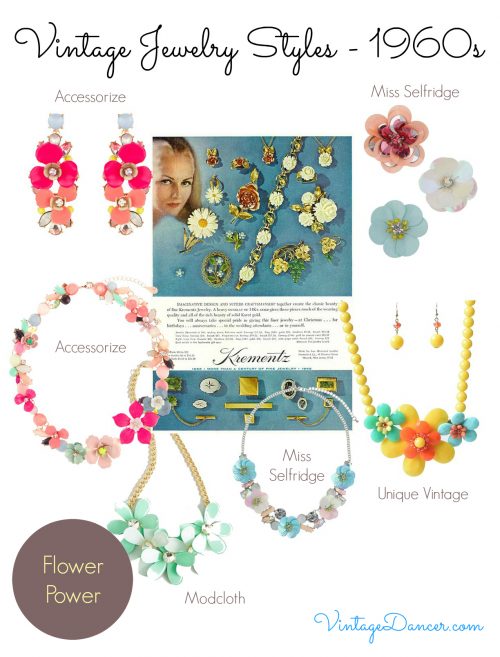
Floral styles became chunky and bold, fashioned in new resins and plastics.
The new resins and plastics of the time allowed designs to become big and brash. Costume jewelry of the 1960s was all about generating attention. No color was off limits.
The counter-culture of the decade and youth culture both inspired and influenced the era. The Baby Boomers of the 1960s wanted to detach themselves from the ideals and attitudes of their elders. These teenagers and young adults wanted to create their own opinions, unfettered by the influence of their parents and the elder generation.
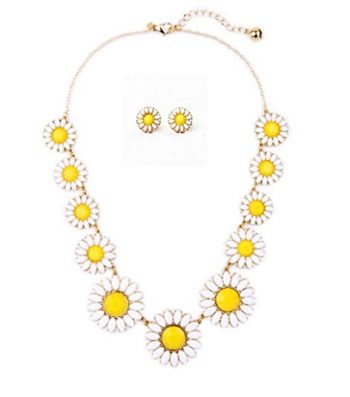
60s daisy necklace and earrings on Amazon
1960s Jewelry Styles: Long Earrings
Pierced ear lobes had by now, once again, become socially acceptable. Now women could wear long, large earrings — and the bigger, the better. As women started to wear their hair shorter or tucked back under a headband, this focused attention on the neck and ears. The ear lobes became the perfect place to sport oversized hoops in the new Perspex materials of the day.
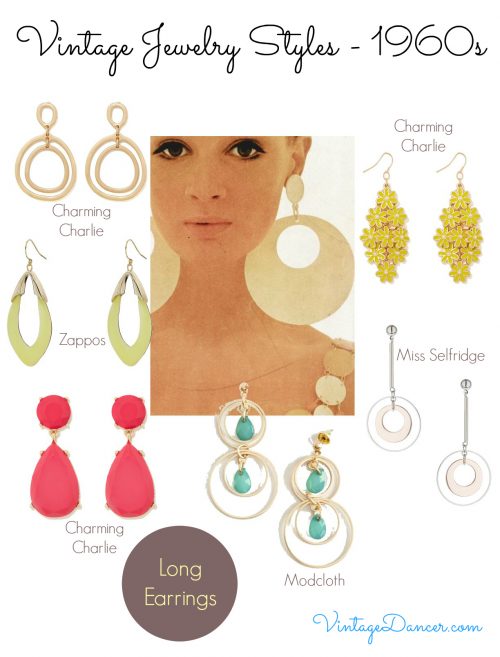
During the 1960s, as hairstyles became shorter long earrings grew in popularity.
You may have noticed that ’60s jewelry is back in style now (as of 2018). Big colorful hoop earrings are easy to find.
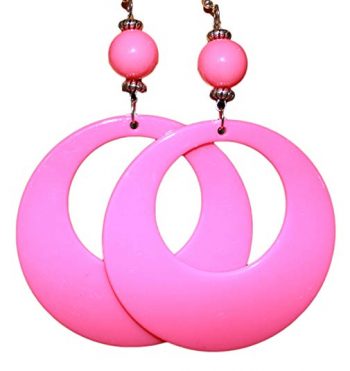
Mod 60s hoop earrings in many colors on Amazon
Strong Colors and Bold Color Combinations
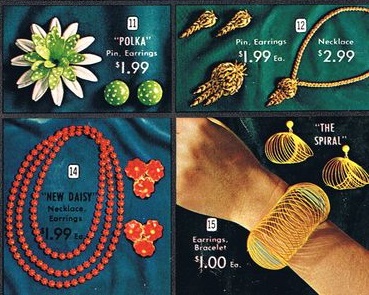
Color and gold! 1960s jewelry sold in a Wards catalog
By the 1960s, colors were unashamedly bold. Patterns and combinations were sometimes designed to clash on purpose. The mood of the decade was all about youth. New ideas were explored as a result of this. Color combinations were created to shock.
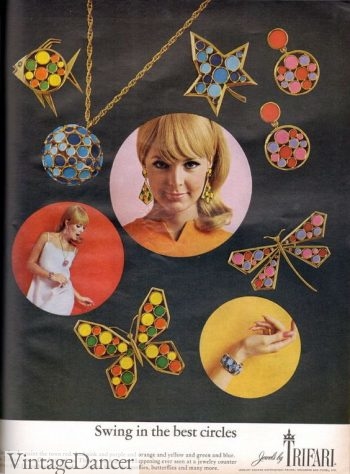
Bold color combinations displayed in this Trifari jewelry advert from 1967.
Mass production encouraged a throw-away consumer attitude, resulting in a “buy it one day, dispose of it the next day” outlook. This freedom allowed consumers to purchase cheap costume jewelry that previously they may not have had the courage or financial backing to do so.
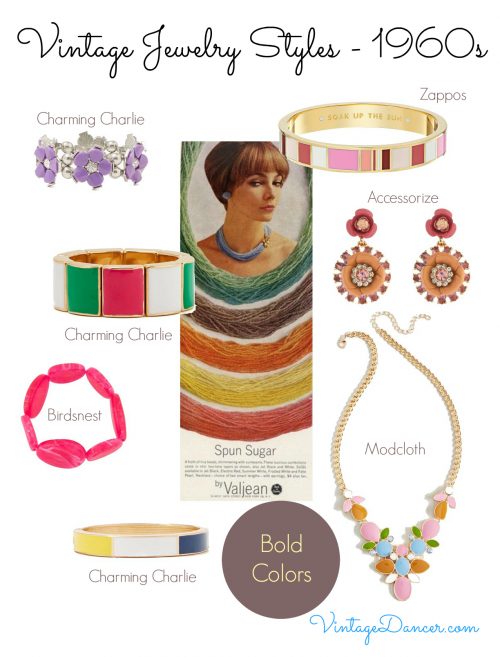
Unusual color combinations were popular during the 1960s. Choose from these
Big cocktail rings continued to be worn in the 1960s. Designs became even bigger, more colors and with global influences. In the late 1960s, Indian inspired arts influenced both fashion and jewelry. The hippie movement was coming.
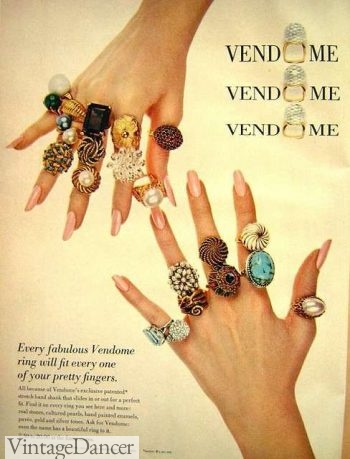
1969 big cocktail rings with an Indian inspired look by Vendome
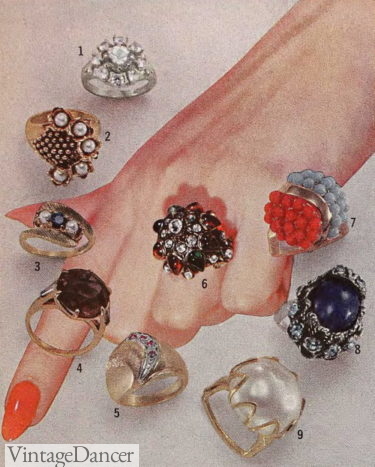
1964 cocktail rings
1960s Jewelry Styles: Bangles
Mass production enabled women to accessorize their outfits more easily and cheaply than ever before. Bangles became increasingly popular. Available in a host of colors, bangles were the ultimate 1960s accessory. Bangles enabled women to update their outfits quickly and easily, and often, bangles were able to employ a host of trends combined. Chunky oversized bangles in jarring color combinations were the perfect 1960s accessory, as were stacks of thin bangles cascading the entire arm.
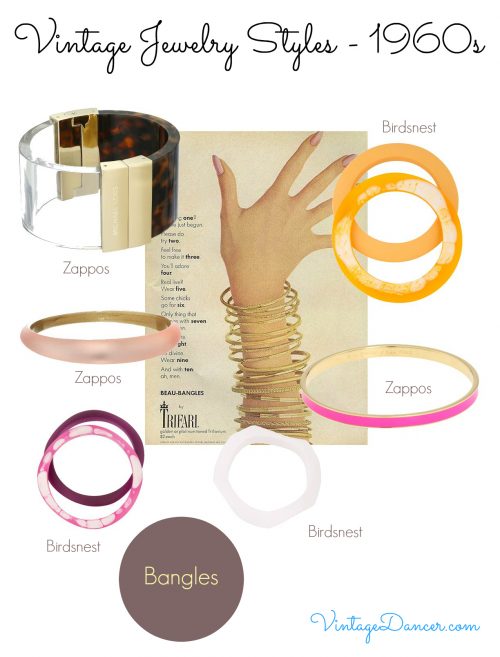
Bangles were a quick and easy option to update an outfit during the 1960s.
Key Jewelry Styles of the 1960s
- Art Influencing Fashion – Pop Art and Op Art greatly influenced fashion and jewelry designs.
- Plastics and Perspex – Jewelry designs were produced in new materials as a result of mass production. Plastics and resins were increasingly popular during this decade.
- Flower Power – Floral designs were popular towards the end of the decade, especially daisies.
- Bold Color Combinations – The fashions of the 1960s were created to attract visual impact. Jewelry designs featured bold colors, often with lurid man-made combinations paired together.
- Geometric Shapes – The Space Age influenced jewelry and fashion design, with metal designs in geometric shapes becoming popular.
